Erbil
Erbil or Hawler (Kurdish: ھەولێر ,Hewlêr[2][3]; Arabic: أربيل[4]; Syriac: ܐܲܪܒܹܝܠ[5]), known in ancient history as Arbela and also spelled Arbil, Arbel and Irbil, is the capital and most populated city in the Kurdistan Region in northern Iraq.[6] It has about 879,000 inhabitants,[1] and Erbil Governorate has a permanent population of 2,009,367 as of 2015.[7]
Erbil Hewlêr ,ھەولێر ܐܲܪܒܹܝܠ أربيل | |
|---|---|
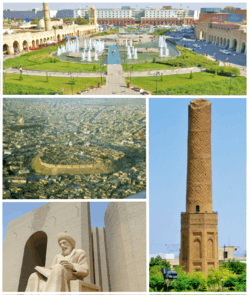 | |
| Nickname(s): Hawler | |
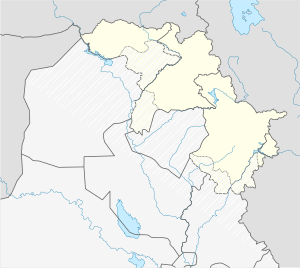 Erbil Location of Erbil 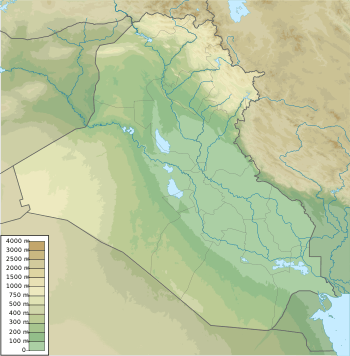 Erbil Erbil (Iraq) | |
| Coordinates: 36.191188°N 44.009189°E | |
| Country | Iraq |
| Region | Kurdistan Region |
| Governorate | Erbil |
| Government | |
| • Mayor | Firsat Sofi |
| Area | |
| • Total | 115 km2 (44 sq mi) |
| • Land | 113 km2 (44 sq mi) |
| • Water | 2 km2 (0.8 sq mi) |
| Elevation | 390 m (1,280 ft) |
| Population (2018) | |
| • Total | 879,000[1] |
| Time zone | UTC+3 (AST) |
| Postal code | 44001 |
| Area code(s) | 066 |
| Website | HawlerGov.org |
Human settlement at Erbil may be dated back to the 5th millennium BC, which would make the city one of the oldest continuously inhabited areas in the world.[8] At the heart of the city is the ancient Citadel of Erbil and Mudhafaria Minaret. The earliest historical reference to the region dates to the Third Dynasty of Ur of Sumer, when King Shulgi mentioned the city of Urbilum. The city was later conquered by the Assyrians.[9][10]
Erbil became an integral part of the kingdom of Assyria by the 21st century BC through to the end of the seventh century BC, after it was captured by the Gutians, and it was known in Assyrian annals variously as Urbilim, Arbela and Arba-ilu. Subsequent to this, it was part of the geopolitical province of Assyria under several empires in turn, including the Median Empire, the Achaemenid Empire (Achaemenid Assyria), Macedonian Empire, Seleucid Empire, Armenian Empire, Parthian Empire, Roman Assyria and Sasanian Empire (Asōristān), as well as being the capital of the tributary state of Adiabene between the mid-second century BC and early second century AD.
Following the Muslim conquest of Persia, it no longer remained a unitary region, and during the Middle Ages, the city came to be ruled by the Seljuk and Ottoman empires.[11]
Erbil's archaeological museum houses a large collection of pre-Islamic artefacts, particularly the art of Mesopotamia, and is a center for archaeological projects in the area.[12] The city was designated as Arab Tourism Capital 2014 by the Arab Council of Tourism.[13][14] In July 2014, the Citadel of Arbil was inscribed as a World Heritage site.
The city has an ethnically diverse population of Kurds (the majority ethnic group), Turkmens, Assyrians, Arabs, Shabaks, Mandaeans and Armenians. It is equally religiously diverse, with believers of Sunni Islam, Shia Islam, Christianity, Yazidism, Yarsanism, Shabakism and Mandaeism extant in and around Erbil.
Etymology
The name Erbil was mentioned in Sumerian holy writings of third millennium BC as Urbilum, Urbelum or Urbillum,[10] which appears to originate from Arbilum.[15] Later, the Akkadians and Assyrians by a folk etymology rendered the name as arba'ū ilū to mean (four gods).[15] The city became a centre for the worship of the Mesopotamian goddess Ishtar. In classical times the city became known as Arbela (Koinē Greek: Ἄρβηλα), from the Syriac form of the name. In Old Persian, the city was called Arbairā.[16]
Today, the modern Kurdish name of the city, Hewlêr, appears to be a corruption of the name Arbel by a series of metatheses of consonants.[15]
History
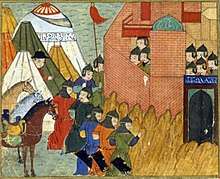
%2C_Iraqi_Kurdistan.jpg)
.jpg)
Ancient history
The region in which Erbil lies was largely under Sumerian domination from c. 3000 BC, until the rise of the Akkadian Empire (2335–2154 BC) which united all of the Akkadian Semites and Sumerians of Mesopotamia under one rule. Today the Assyrian people, a Syriac-speaking community who claim descent from Akkadian speakers, endure as a minority in northern Iraq, north east Syria, south east Turkey and north west Iran, their population is estimated to be 3.3 million.[17]
The first mention of Erbil in literary sources comes from the archives of the East Semitic-speaking kingdom of Ebla. They record two journeys to Erbil (Irbilum) by a messenger from Ebla around 2300 BC. Erridupizir, king of the language isolate speaking kingdom of Gutium, captured the city in 2150 BC.[18] The Neo-Sumerian ruler of Ur, Amar-Sin, sacked Urbilum in his second year, c. 1975 BC.[10]
Erbil was an integral part of Assyria from around 2050 BC, becoming a relatively important city during the Old Assyrian Empire (1975–1750 BC), Middle Assyrian Empire (1365–1050 BC) and the Neo Assyrian Empire (935–605 BC), until the last of these empires fell between 612–599 BC. However, it remained part of Assyria under Persian, Greek, Parthian, Roman and Sassanid rule until the first half of the 7th century AD.
Under the Median Empire, Cyaxares might have settled a number of people from the Ancient Iranian tribe of Sagartians in the Assyrian cities of Arbela and Arrapha (modern Kirkuk), probably as a reward for their help in the capture of Nineveh.[19] The Persian emperor Cyrus the Great occupied Assyria in 547 BC and established it as an Achaemenid satrapy called in Old Persian Aθurā (Athura), with Arbela as the capital.[20]
The Battle of Gaugamela, in which Alexander the Great defeated Darius III of Persia, took place in 331 BC approximately 100 kilometres (62 mi) west of Erbil. After the battle, Darius managed to flee to the city. (Somewhat inaccurately, the confrontation is sometimes known as the "Battle of Arbela".) Subsequently, Arbela was part of Alexander's Empire. After the death of Alexander the Great in 323 BC, Arbela became part of the Hellenistic Seleucid Empire.
Erbil became part of the region disputed between Rome and Persia under the Sasanids. The ancient Assyrian kingdom of Adiabene (the Greek form of the Assyrian Ḥadyab) had its centre at Erbil, and the town and kingdom are known in Jewish history for the conversion of the royal family to Judaism.[21] During the Parthian era to early Sassanid era, Erbil became the capital of the Assyrian state of Adiabene.
Its populace then gradually converted from the Mesopotamian religion between the 1st and 4th centuries to Christianity—primarily the Chaldean Catholic Church (and to a lesser degree to the Syriac Orthodox Church)), with Pkidha traditionally becoming its first bishop around 104 AD. The ancient Mesopotamian religion did not die out entirely in the region until the 10th century AD.[22][23] The metropolitanate of Ḥadyab in Arbela (Syriac: ܐܪܒܝܠ Arbel) became a centre of eastern Syriac Christianity until late in the Middle Ages.[24]
Medieval history
As many of the Assyrians who had converted to Christianity adopted Biblical (including Jewish) names, most of the early bishops had Eastern Aramaic or Jewish/Biblical names, which does not suggest that many of the early Christians in this city were converts from Judaism.[25] It served as the seat of a Metropolitan of the Assyrian Church of the East. From the city's Christian period come many church fathers and well-known authors in Syriac.
Following the Muslim conquest of Persia, the Sasanid province of Assuristan, of which Erbil made part of, was dissolved, and from the mid 7th century AD the region saw a gradual influx of Muslim peoples, predominantly Arabs, Kurds and Turkic peoples.
The most notable Kurdish tribe in the region were the Hadhabani, of which several individuals also acted as governors for the city from the late 10th century until the 12th century when it was conquered by the Zengids and its governorship given to the Turkic Begtegenids, of whom the most notable was Gökböri, who retained the city during the Ayyubid era [26][27] Yaqut al-Hamawi further describes Erbil as being mostly Kurdish-populated in the 13th century.[28]
When the Mongols invaded the Near East in the 13th century, they attacked Arbil for the first time in 1237. They plundered the lower town but had to retreat before an approaching Caliphate army and had to put off the capture of the citadel.[29] After the fall of Baghdad to Hülegü and the Mongols in 1258, the last Begtegenid ruler surrendered to the Mongols, claiming the Kurdish garrison of the city would follow suit; they refused this however, therefore the Mongols returned to Arbil and were able to capture the citadel after a siege lasting six months.[30][31] Hülegü then appointed an Assyrian Christian governor to the town, and the Syriac Orthodox Church was allowed to build a church.
As time passed, sustained persecutions of Christians, Jews and Buddhists throughout the Ilkhanate began in earnest in 1295 under the rule of Oïrat amir Nauruz, which affected the indigenous Assyrian Christians greatly.[32] This manifested early on in the reign of the Ilkhan Ghazan. In 1297, after Ghazan had felt strong enough to overcome Nauruz's influence, he put a stop to the persecutions.
During the reign of the Ilkhan Öljeitü the Assyrian inhabitants retreated to the citadel to escape persecution. In the Spring of 1310, the Malek (governor) of the region attempted to seize it from them with the help of the Kurds. Despite the Turkic bishop Mar Yahballaha's best efforts to avert the impending doom, the citadel was at last taken after a siege by Ilkhanate troops and Kurdish tribesmen on 1 July 1310, and all the defenders were massacred, including many of the Assyrian inhabitants of the lower town.[33][34]
However, the city's Assyrian population remained numerically significant until the destruction of the city by the forces of Timur in 1397.[35]
In the Middle Ages, Erbil was ruled successively by the Umayyads, the Abbasids, the Buwayhids, the Seljuks and then the Turkmen Begtegīnid Emirs of Erbil (1131–1232), most notably Gökböri, one of Saladin's leading generals; they were in turn followed by the Ilkhanids, the Jalayirids, the Kara Koyunlu, the Timurids and the Ak Koyunlu. Erbil was the birthplace of the famous 12th and 13th century Kurdish historians and writers Ibn Khallikan and Ibn al-Mustawfi. After Battle of Chaldiran in 1514 Erbil came under Soran emirate In 18th century Baban Emirate took the city but it was retaken by Soran ruler Mir Muhammed Kor in 1822 The Soran emirate continued ruling over Erbil until it was taken by the Ottomans in 1851. Erbil became a part of the Musul Vilayet in Ottoman Empire for until World War I, when the Ottomans and their Kurdish and Turcoman allies were defeated by the British Empire.
Modern history

The modern town of Erbil stands on a tell topped by an Ottoman fort. During the Middle Ages, Erbil became a major trading center on the route between Baghdad and Mosul, a role which it still plays today with important road links to the outside world.
Today, Erbil is both multi-ethnic and multi-religious, with the Kurds forming the largest ethnic group in the city, with smaller numbers of Arabs, Assyrians, Turcoman, Armenians, Yazidis, Shabaks, Circassians, Kawliya, Iranians and Mandeans also extant. Erbil is also home to a large population of refugees due to ongoing conflicts in Syria and in the rest of Iraq. In 2020, it was estimated that 450,000 refugees had settled in the Erbil metropolitan area since 2003, with many of them expected to remain.[36]
The parliament of the Kurdistan Autonomous Region was established in Erbil in 1970 after negotiations between the Iraqi government and the Kurdistan Democratic Party (KDP) led by Mustafa Barzani, but was effectively controlled by Saddam Hussein until the Kurdish uprising at the end of the 1991 Gulf War. The legislature ceased to function effectively in the mid-1990s when fighting broke out between the two main Kurdish factions, the Kurdistan Democratic Party and the Patriotic Union of Kurdistan (PUK). The city was captured by the KDP in 1996 with the assistance of the Iraqi government of Saddam Hussein. The PUK then established an alternative Kurdish government in Sulaimaniyah. KDP claimed that on March 1996 PUK asked for Iran's help to fight KDP. Considering this as a foreign attack on Iraq's soil, the KDP asked Saddam Hussein for help.
The Kurdish Parliament in Erbil reconvened after a peace agreement was signed between the Kurdish parties in 1997, but had no real power. The Kurdish government in Erbil had control only in the western and northern parts of the autonomous region. During the 2003 Invasion of Iraq, a United States special forces task force was headquartered just outside Erbil. The city was the scene of celebrations on 10 April 2003 after the fall of the Ba'ath regime.
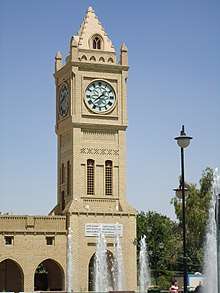
During the coalition forces occupation of Iraq, sporadic attacks hit Erbil. Parallel bomb attacks against Eid celebrations killed 109 people on 1 February 2004.[37] Responsibility was claimed by the Ansar al-Sunnah,[37] and stated to be in solidarity with Ansar al-Islam. A suicide bombing on 4 May 2005 killed 60 civilians and injured 150 more outside a police recruiting centre.[38]
The Erbil International Airport opened in the city in 2005.
In 2015, the Assyrian Church of the East moved its seat from Chicago to Erbil.
Transportation
Erbil International Airport is one of Iraq's busiest airports and it is near the city. Services include direct flights to many domestic destinations such as Baghdad international airport. There are international flights from Erbil to many countries; such as the Netherlands, Germany, Saudi Arabia, Austria, Turkey, Jordan and many more flights elsewhere around the world. There are occasionally seasonal flights from Erbil international airport. Erbil International Airport was briefly closed to international commercial flights in September 2017 by the Iraqi government in retaliation for the Kurdish independence vote but reopened in March 2018.[39][40]
Another important form of transportation between Erbil and the surrounding areas is by bus. Among others, bus services offer connections to Turkey and Iran. A new bus terminal was opened in 2014.[41]
Most of Kurdistan's transportation is with local Taxis, which are operated by private companies and also managed by the government of Kurdistan.
Erbil has a system of five ring roads encirling the city.[42]
Climate
Erbil has a Mediterranean climate (Köppen climate classification Csa), with long, extremely hot summers and mild winters. Summer months are extremely dry, with little to no precipitation occurring between June and September. Winters are usually wet and humid, with January being the wettest month.[43]
| Climate data for Erbil | |||||||||||||
|---|---|---|---|---|---|---|---|---|---|---|---|---|---|
| Month | Jan | Feb | Mar | Apr | May | Jun | Jul | Aug | Sep | Oct | Nov | Dec | Year |
| Average high °C (°F) | 12.4 (54.3) |
14.2 (57.6) |
18.1 (64.6) |
24.0 (75.2) |
31.5 (88.7) |
38.1 (100.6) |
42.0 (107.6) |
41.9 (107.4) |
37.9 (100.2) |
30.7 (87.3) |
21.2 (70.2) |
14.4 (57.9) |
27.2 (81.0) |
| Daily mean °C (°F) | 7.4 (45.3) |
8.9 (48.0) |
12.4 (54.3) |
17.5 (63.5) |
24.1 (75.4) |
29.7 (85.5) |
33.4 (92.1) |
33.1 (91.6) |
29.0 (84.2) |
22.6 (72.7) |
15.0 (59.0) |
9.1 (48.4) |
20.2 (68.3) |
| Average low °C (°F) | 2.4 (36.3) |
3.6 (38.5) |
6.7 (44.1) |
11.1 (52.0) |
16.7 (62.1) |
21.4 (70.5) |
24.9 (76.8) |
24.4 (75.9) |
20.1 (68.2) |
14.5 (58.1) |
8.9 (48.0) |
3.9 (39.0) |
13.2 (55.8) |
| Average rainfall mm (inches) | 111 (4.4) |
97 (3.8) |
89 (3.5) |
69 (2.7) |
26 (1.0) |
0 (0) |
0 (0) |
0 (0) |
0 (0) |
12 (0.5) |
56 (2.2) |
80 (3.1) |
540 (21.2) |
| Average rainy days | 9 | 9 | 10 | 9 | 4 | 1 | 0 | 0 | 1 | 3 | 6 | 10 | 62 |
| Average snowy days | 1 | 0 | 0 | 0 | 0 | 0 | 0 | 0 | 0 | 0 | 0 | 0 | 1 |
| Average relative humidity (%) | 75 | 70 | 65 | 59 | 42 | 29 | 25 | 28 | 31 | 44 | 61 | 76 | 50 |
| Source 1: Climate-Data.org,[43] My Forecast for records, humidity, snow and precipitation days[44] | |||||||||||||
| Source 2: What's the Weather Like.org,[45] Erbilia[46] | |||||||||||||
Culture
Citadel of Erbil
The Citadel of Erbil is a tell or occupied mound in the historical heart of Erbil, rising between 25 and 32 metres (82 and 105 ft) from the surrounding plain. The buildings on top of the tell stretch over a roughly oval area of 430 by 340 metres (1,410 ft × 1,120 ft) occupying 102,000 square metres (1,100,000 sq ft). It has been claimed that the site is the oldest continuously inhabited town in the world.[47] The earliest evidence for occupation of the citadel mound dates to the 5th millennium BC and possibly earlier. It appears for the first time in historical sources during the Ur III period and gained particular importance during the Neo-Assyrian Empire (10th to 7th centuries BC) period. West of the citadel at Ary Kon quarter, a chamber tomb dating to the Neo-Assyrian Empire period has been excavated.[12] During the Sassanian period and the Abbasid Caliphate, Erbil was an important centre for Assyrian Christianity and the Assyrians. After the Mongols captured the citadel in 1258, Erbil's importance began to decline.
During the 20th century, the urban structure was significantly modified, as a result of which a number of houses and public buildings were destroyed. In 2007, the High Commission for Erbil Citadel Revitalization (HCECR) was established to oversee the restoration of the citadel. In the same year, all inhabitants, except one family, were evicted from the citadel as part of a large restoration project. Since then, archaeological research and restoration works have been carried out at and around the tell by various international teams and in co-operation with local specialists, and many areas remain off-limits to visitors due to the danger of unstable walls and infrastructure. The government plans to have 50 families live in the citadel once it is renovated.
The only religious structure that currently survives in the citadel is the Mulla Afandi Mosque. When it was fully occupied, the citadel was divided in three districts or mahallas: from east to west the Serai, the Takya and the Topkhana. The Serai was occupied by notable families; the Takya district was named after the homes of dervishes, which are called takyas; and the Topkhana district housed craftsmen and farmers. Other sights to visit in the citadel include the bathing rooms (hammam) built in 1775 located near the mosque and the Textile Museum.[48] Erbil citadel has been inscribed on the World Heritage List on 21 June 2014 .
Other sights
- The covered Erbil Qaysari Bazaars, lying below the main entrance to the citadel and stocking mainly household goods and tools.
- The 36-metre-high (118-foot) Mudhafaria Minaret, situated in Minaret Park several blocks from the citadel, dates back to the late 12th century AD and the Governor of Erbil, in the reign of Saladin, Muzaffar Al-Din Abu Sa’eed Al-Kawkaboori (Gökböri), who had entered in the obedience of Salahuddin without war and married his sister. It has an octagonal base decorated with two tiers of niches, which is separated from the main shaft by a small balcony, also decorated. Another historical minaret with turquoise glazed tiles is nearby.
- Sami Abdul Rahman Park
- Franso Hariri Stadium
- The Mound of Qalich Agha lies within the grounds of the Museum of Civilization, 1 kilometre (0.62 mi) from the citadel. An excavation in 1996 found tools from the Halaf, Ubaid and Uruk periods.[12]
- Kurdish Textile Museum
Sports
The local major football team is Erbil Soccer Club which plays its football matches at Franso Hariri Stadium (named after the assassinated Assyrian politician, former governor of Erbil city Franso Hariri) which is based in the south part of central Erbil. Erbil Football Team Wins 3 Iraqi nation league and reached the AFC Final twice, but lost both times.
Media
- Babylon FM
- Ishtar TV
- Kanal4
- Kurdistan 24
- Kurdistan TV
- Kurdmax Pepûle
- Kurdsat
- Net TV
- Rudaw Media Network
- Ava Entertainment
- Korek TV
- I Star
- I Star Sport
- I Star Quran
- new line HD
- Speda Channel
Arts
Erbil is very well known for a style of Kurdish Hairan with many singers who long served to improve the art form in the region and left a long legacy that is rich with many famous songs singers such the three brothers Osman, Khdr and Hassan Hairan, many other modern art forms have emerged in the area such a Rap, Breakdance and Slam Poetry.
Other art forms like traditional singing in small circles is very famous in Erbil, Singers like Karwan Khabati, Awat Bokani, Farman Belana and Khdr Begalasi who are prominent names and perform 3-5 times a week at private and public events, these folk singers make up to 10,000$ a session in Erbil while in other cities they could make $1,000, therefore, they try their best to make a name for themselves in Erbil.
See also
| Wikimedia Commons has media related to Arbil. |
- Ankawa – a suburb
- Assyrian homeland
- Erbil Governorate
- Erbil International Airport – capital's airport in Kurdistan
- List of cities of the ancient Near East
References
- "Iraq". CITY POPULATION. Retrieved 5 September 2017.
- "Hewlêr dixwaze Bexda paşekeftiya mûçeyan bide" (in Kurdish). Retrieved 28 December 2019.
- "ھەولێر بووە ئەندامی رێکخراوی نێودەوڵەتی شارەکانی فرانکوفون2019". Rûdaw (in Kurdish). Retrieved 28 December 2019.
- "أربيل". Aljazeera (in Arabic). Retrieved 28 December 2019.
- "Search Entry". Assyrian Languages. Retrieved 10 March 2020.
- Danilovich, Alex (12 October 2018). Federalism, Secession, and International Recognition Regime: Iraqi Kurdistan. Routledge. ISBN 9780429827655.
- "İşte Kürdistan Bölgesi'nin nüfusu…". Rudaw.net.
- Novice, Karel (2008). "Research of the Arbil Citadel, Iraq, First Season". Památky Archaeological (XCIX): 259–302.
- Villard 2001
- Hamblin, William J. (2006). Warfare in the Ancient Near East to 1600 BC. Routledge. p. 111. ISBN 0-415-25589-9.
- Georges Roux – Ancient Iraq
- 'Directorate Antiquities of Erbil's Guide' Brochure produced by General Directorate of Antiquities, KRG, Ministry of Tourism
- Erbil named 2014 Arab Tourism Capital. Retrieved 30 January 2014
- "Erbil: Kurdish City, Arab Capital", Rudaw. Retrieved 30 January 2014
- Khan, Geoffrey (1999). A grammar of neo-Aramaic: the dialect of the Jews of Arbel, Part 1, Volume 47. BRILL. p. 2. ISBN 978-90-04-11510-1.
- "Iranica: Arbela". Iranicaonline.org. Retrieved 21 May 2012.
- Statistics. "UNPO: Assyria". unpo.org.
- Timeline Archived 14 August 2014 at the Wayback Machine ErbilCitadel.orq
- electricpulp.com. "ASAGARTA (Sagartia) – Encyclopaedia Iranica". iranicaonline.org. Archived from the original on 18 December 2016. Retrieved 14 September 2011.
- E. Herzfeld, The Persian Empire, ed. G. Walser, Wiesbaden, 1968, pp. 304–07
- Adiabene, Jewish Kingdom of Mesopotamia Archived 12 July 2009 at the Portuguese Web Archive, Jonah Gabriel Lissner
- MŠIHA-ZKHA. "HISTORY OF THE CHURCH OF ADIABENE UNDER THE PARTHIANS AND THE SASSANIDS". Tertullian.org.
- Neusner, Jacob (1969). A history of the Jews in Babylonia, Volume 2. Brill Archive. p. 354.
- British Institute of Persian Studies (1981). Iran, Volumes 19–21. the University of Michigan. pp. 15, 17.
- Gillman, Ian and Hans-Joachim Klimkeit. Christians in Asia before 1500. (Ann Arbor: University of Michigan, 1999) p. 33
- V. Minorsky. Studies in Caucasian History III, Prehistory of Saladin. Cambridge University Press. 208 pp. 1953.
- Nováček, K., Amin, N., & Melčák, M. (2013). A Medieval City Within Assyrian Walls: The Continuity of the Town of Arbīl in Northern Mesopotamia. Iraq, 75, 1-42. doi:10.1017/S0021088900000401
- B. James. Le « territoire tribal des Kurdes » et l’aire iraqienne (xe-xiiie siècles): Esquisse des recompositions spatiales. Revue des Mondes Musulmans et de la Méditerranée, 2007. P. 101-126.
- Woods 1977, pp. 49–50
- Nováček et al. 2008, p. 261
- J. von Hammer-Purgstall. 1842. Geschichte der Ilchane, das ist der Mongolen in Persien, Volume 1. P. 159-161.
- Grousset, p. 379
- Sourdel 2010
- Grousset, p. 383
- Edwin Munsell Bliss, Turkey and the Armenian Atrocities, (Chicago 1896) p. 153
- "Interview with Nihad Salim Qoja: "Iranian hegemony in Iraq is very strong" - Qantara.de". Qantara.de - Dialogue with the Islamic World. Retrieved 18 July 2020.
- Al-Nahr, Naseer (2 February 2004). "Twin Bombings Kill 56 in Irbil". Arabnews.com. Retrieved 11 May 2015.
- Jaff, Warzer; Oppel Jr., Richard A. (5 May 2005). "60 Kurds Killed by Suicide Bomb in Northern Iraq". The New York Times. Retrieved 11 May 2015.
- Blockade by Iraq (29 September 2017). "Iraqi govt enforces international flight ban in Kurdistan region". France 24.
- International Flight Return. "Erbil International Airport". erbilairport.com.
- "Erbil's New Bus Terminal a Boon for Travelers". Rudaw. 4 April 2019. Retrieved 19 March 2019.
- "Erbil's 5th ring road completed - the 120 Meter highway". Rudaw. 2 May 2017. Retrieved 19 March 2019.
- "Climate: Arbil – Climate graph, Temperature graph, Climate table". Climate-Data.org. Retrieved 13 August 2013.
- "Irbil, Iraq Climate". My Forecast. Retrieved 14 July 2013.
- "Erbil climate info". What's the Weather Like.org. Retrieved 14 July 2013.
- "Erbil Weather Forecast and Climate Information". Erbilia. Archived from the original on 9 July 2013. Retrieved 14 July 2013.
- "Erbil Citadel". UNESCO. Retrieved 30 August 2010.
- 'Erbil Citadel' Brochure, High Commission for Erbil Citadel Revitalization (HCECR). www.erbilcitadel.org
Sources
- Sourdel, D. (2010), "Irbil", in Bearman, P.; Bianquis, Th.; Bosworth, C.E.; van Donzel, E.; Heinrichs, W.P. (eds.), Encyclopaedia of Islam, Second Edition, Brill Online, OCLC 624382576
- Grousset, René, The Empire of the Steppes, (Translated from the French by Naomi Walford), New Brunswick: Rutgers University Press (1970)
External links
| Wikivoyage has a travel guide for Erbil. |
- Hawler Governorate
- Erbil – Portal for international visitors
- Livius.org: Arbela
- Erbil Information Guide
- Hawler/Erbil visitor's guide
- Erbil seen through camera lens